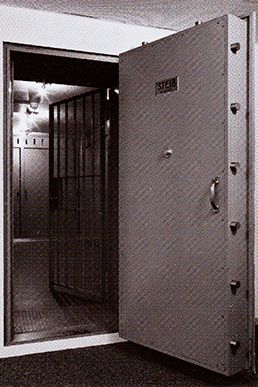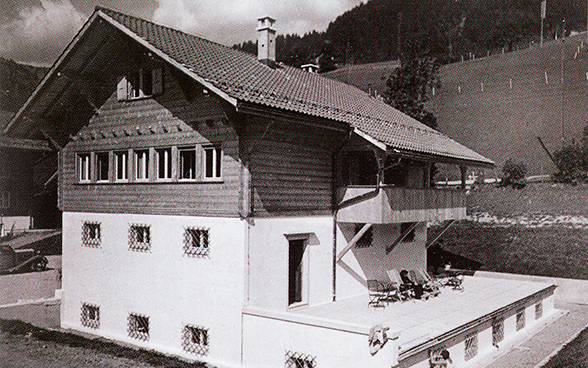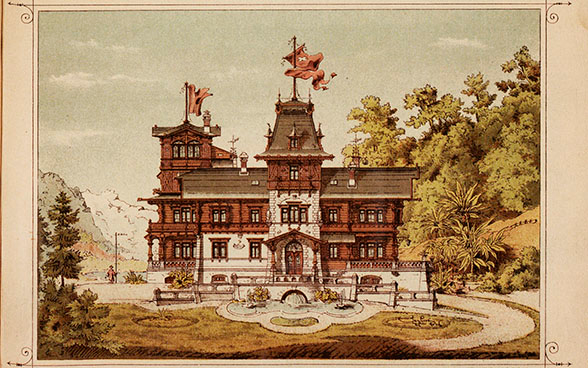The chalet is a symbol of Switzerland – simple, close to nature, free and democratic – and it also captures the imaginations of foreign visitors. The National Library collections – as well as the NL exhibition “Chalet: Nostalgia, kitsch and Baukultur” from 10 March to 30 June 2023 – offer surprising insights into these sentimental Swiss structures.
High above, mountain peaks within reach, surrounded by evergreen forests: there it is – my chalet. The poem “My Chalet” is an homage written in the patois spoken in the Canton of Vaud:
[…]
Lâi passe mè momeint lè pye bî
Et mè z’hâorè lè pye ballè,
Lyein dâi couson, lyein dâo traffi,
Per ice, dein mon petit tsalet.
[…]
(It is here where I spend my loveliest moments and my loveliest hours, free from worry and away from the hustle and bustle – here in my chalet.)
The eternal Swiss chalet
The term chalet, which originates in Western Switzerland, is not only known regionally but also across the nation – and the globe. And chalets don’t only garner praise from poets. Take, for example, this book review quoted by the architectural magazine Das Werk: “It is no exaggeration to put the chalet on the same level as the architectural monuments of Rome, France and Italy.” In the 19th century, the stereotypical Swiss chalet enjoyed increasing popularity and became a sought-after international export. Because of how they are constructed, chalets are ideal for semi-industrial pre-fabrication and the shipment of their individual components. This is how the chalet – in the form of a kit – became immortalised around the world.
The royal chalet
Around 1895, the company Kuoni & Cie from Chur delivered a Swiss chalet to Count Tokugawa in Japan. Chalet Tokugawa is an imposing building that is more akin to a palace than a humble mountain structure. With its wooden beam construction, however, it still reflects the typical characteristics of a chalet. Kuoni & Cie’s work on the royal Japanese chalet garnered them a silver medal at the 1896 national exhibition in Geneva.
The armoured chalet

6 by 3.80 metres and boasted 60-centimetre walls
© Bâloise Holding AG, company archive
An interesting story about a chalet in Saanen, near Gstaad, came to light on the 150-year anniversary of insurance company Basler Versicherungen in 2013. Well before the outbreak of the Second World War, the company was aware that the city of Basel would be extremely vulnerable in the event of a war. The company was especially concerned about the risk of being bombed. What would happen to all of their countless documents detailing customer relationships and legal claims? What about their securities, which at the time were physically held by their owners? Basler Versicherungen therefore developed emergency measures, some of which they carried out. Saanen, located near the village of Gstaad, was declared to be the wartime headquarters. The insurer built their own fortified compound there, complete with walk-in vaults and space for their Hollerith data processing equipment – all of which was camouflaged as an inconspicuous group of four chalets that looked typical for the area. Upon closer inspection, however, some atypical features jump out: a lot of reinforced concrete with high walls and little wood. In May 1940, an emergency team was even moved to Saanen, with up to 50 employees living and working there, some with their families, until the end of the war.
The Swiss Postal Telegraph and Telephone agency (PTT) also planned for the capture of the city of Bern and asked Basler Versicherungen for a chalet vault to house their stamp reserves. The reserves that were temporarily stored in the secret vault were worth 75 million francs, or 410 million francs in today’s figures.
From fortress to hotel
Shortly after the war ended, Basler Versicherungen decided to turn its empty chalets in Saanen into holiday homes for employees. The fortresses were transformed into idyllic places of rest and relaxation for staff. The chalets slowly grew older and were then replaced with a new building: the three-star Spitzhorn hotel opened its doors on the same grounds in December 2013. Perhaps on your next hotel stay, you can try to find the secret vault.
Bibliography and sources
- “Als die Balôise ihr Reduit baute”, in: Berner Zeitung online. Published on 05.12.2013, accessed on 14.02.2023.
- Escher, Markus und Lüönd, Karl. Sicherheit als Prinzip: 150 Jahre und eine Zukunft für die Basler. Basel: Bâloise Holding AG, 2013, S. 81–105.
- «Ewiges Swiss Chalet», in: Das Werk: Architektur und Kunst = L’œuvre: architecture et art. 1963, Band 50, Heft 11, S. 237.
- Jacquet, Pierre et al. Le chalet suisse = Das Schweizer Chalet = The Swiss chalet. Zurich: Orell Füssli, 1963.
- Malfroy, Sylvain. “Chalet”, in: Historisches Lexikon der Schweiz (HLS), version from 14.07.2005, translated from French, consulted on 01.02.2023.
- “Mon Tsalet”, in: L’ami du patois: trimestriel romand. 1988, Volume 16, Issue 60, p. 18.
Last modification 13.04.2023
Contact
Swiss National Library
SwissInfoDesk
Information Retrieval Service
Hallwylstrasse 15
3003
Bern
Switzerland
Phone
+41 58 462 89 35








